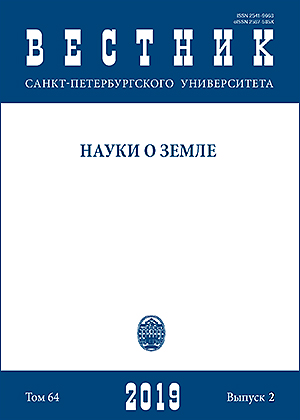The assessment of forest cenotic diversity and its dynamics in Moscow region reference landscapes based on remote sensing data
DOI:
https://doi.org/10.21638/spbu07.2019.202Abstract
The article presents the results of assessment the cenotic variety of glacial and water-ice genesis forest reference landscapes of the Moscow region in different physico-geographical regions, such as Verkhnevolzhskaya lowland, Klinsko-Dmitrovskaya range, Teplostanskaya Upland, Meshcherskaya lowland. The assessment basis was the vegetation map of the Moscow Region (1: 200 000) and space images of the Landsat system. A basic unit of assessment is epiassociation, which presents the ecological condition of the forest cover. It gives the using possibility the ratio of indigenous, short- and long-term communities to determine the extent of human impact and forest ecological functions preservation (Sochava, 1972). Based on the cartographic method of research, landscape complexes of forest types have been identified, and the ecosystem diversity at the local level has been assessed. The vegetation map of the Moscow region has been updated as a result. The authors found that the landscape of Verkhnevolzhskaya lowland the main spaces are occupied by the fir and pine short-term forests. In the landscape of the Klinsko-Dmitrovskaya range and Meshcherskaya lowland dominated by coniferous forests, within Teplostanskaya Upland - coniferous-deciduous forests. In all considered landscapes, the authors noted the strong reduction of forest cover. Primarily it is associated with the human impact increase on natural ecosystems. The strongest reduction in forest areas and forest cover fragmentation occurred in landscapes of Klinsko-Dmitrovskaya range and Teplostanskaya Upland. Based on the data obtained reduction maps of forest cover of reference landscapes were compiled.
The article presents the results of assessment the cenotic variety of glacial and water-ice genesis forest reference landscapes of the Moscow region in different physico-geographical regions, such as Verkhnevolzhskaya lowland, Klinsko-Dmitrovskaya range, Teplostanskaya Upland, Meshcherskaya lowland. The assessment basis was the vegetation map of the Moscow Region (1: 200 000) and space images of the Landsat system. A basic unit of assessment is epiassociation, which presents the ecological condition of the forest cover. It gives the using possibility the ratio of indigenous, short- and long-term communities to determine the extent of human impact and forest ecological functions preservation (Sochava, 1972). Based on the cartographic method of research, landscape complexes of forest types have been identified, and the ecosystem diversity at the local level has been assessed. The vegetation map of the Moscow region has been updated as a result. The authors found that the landscape of Verkhnevolzhskaya lowland the main spaces are occupied by the fir and pine short-term forests. In the landscape of the Klinsko-Dmitrovskaya range and Meshcherskaya lowland dominated by coniferous forests, within Teplostanskaya Upland - coniferous-deciduous forests. In all considered landscapes, the authors noted the strong reduction of forest cover. Primarily it is associated with the human impact increase on natural ecosystems. The strongest reduction in forest areas and forest cover fragmentation occurred in landscapes of Klinsko-Dmitrovskaya range and Teplostanskaya Upland. Based on the data obtained reduction maps of forest cover of reference landscapes were compiled.
Keywords:
forest dynamics, biodiversity, landscape complex of forest types, ecological functions of forest, cartographic research method, remote sensing of forest
Downloads
References
References
Downloads
Published
How to Cite
Issue
Section
License
Articles of "Vestnik of Saint Petersburg University. Earth Sciences" are open access distributed under the terms of the License Agreement with Saint Petersburg State University, which permits to the authors unrestricted distribution and self-archiving free of charge.






